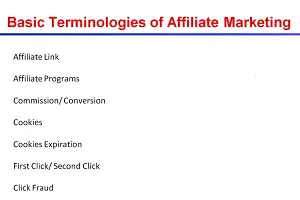In this article, we are going to discuss different types of affiliate programs based on the method of paying commissions to the affiliates. There are primarily 6 different models that the affiliate networks or vendors use the most to determine the commissions to their affiliates.

1. PPC- Pay Per Click Model
As the name says, this model pays the affiliates for every click a visitor makes to the affiliate link or the display advertisement. For example, lets assume you are an affiliate of the Amazon and you pick one product to promote.
Now, you will be given an ad code or affiliate link for that particular product to display the ad on your blog or website. Whenever a visitor lands on your website and clicks that particular ad you will be paid by the Amazon no matter if the visitor purchases that product or not.
The drawback of this model is that the commissions paid per click are very small and the affiliate would need to have a ton of traffic to make some decent earnings out of this model. Also, most of the affiliate networks refrain from providing this model because of high chances of click fraud.
2. PPL- Pay Per Lead Model
This model pays the affiliates for every lead generated and is best suited for affiliates who are beginners. The leads could be sign up using email, Installing app, completing survey etc. This model pays a healthy amount of commissions to the affiliates for every lead generated when compared with pay per click.
But, while using PPL model there is always a chance of dispute between affiliates and the affiliate network over the quality of leads generated. So, to avoid such scenarios it is always recommended to the affiliates to give an idea regarding the sources of traffic you have before promoting pay per lead offers.
3. PPS- Pay Per Sale Model
This is the most preferred model by the affiliate networks. In this model, the affiliate gets the commissions only when the product is sold through that particular affiliate. The possibilities of frauds or disputes are extremely low in this model as the commissions are paid only for the sales made.
The affiliate networks do not have to worry about the quality of traffic the affiliate is using as long as the affiliate is producing genuine sales. This is the main reason that makes this model the first choice of any affiliate network.
4. Sidewide Commissions Model
Lets understand this model with a simple example. Suppose you are an affiliate of Amazon and you have an affiliate link of product X that you are going to promote. Now, some visitor clicks on the affiliate link of product X and lands on Amazon website to buy the product X but instead of buying product X, the visitor ends up buying product Y and the affiliate still gets his commission.
So, in sidewide commissions model, even if a visitor ends up buying the different product even though he/she came by clicking the link of some other product, the affiliate still gets his commission.
5. One Time Commissions Model
In one time commissions model, the affiliate gets only one time commission for each product sold. The affiliate will not get paid for any further purchases the buyer makes for the same product after buying.
6. Recurring Commissions Model
In this model the affiliate gets recurring commissions. For example, if an affiliate is promoting a web hosting service he/she will get commissions on each sale and also gets commissions when the buyer renews or upgrades the web hosting service.
Once sold, the affiliate will keep getting commissions for every renewal made by the buyer for as long as the buyer keeps using it. In other words, for every service or product sold that is subscription based, you will get recurring commissions.
To know more about what exactly affiliate marketing is you can read our dedicated article by clicking HERE.


